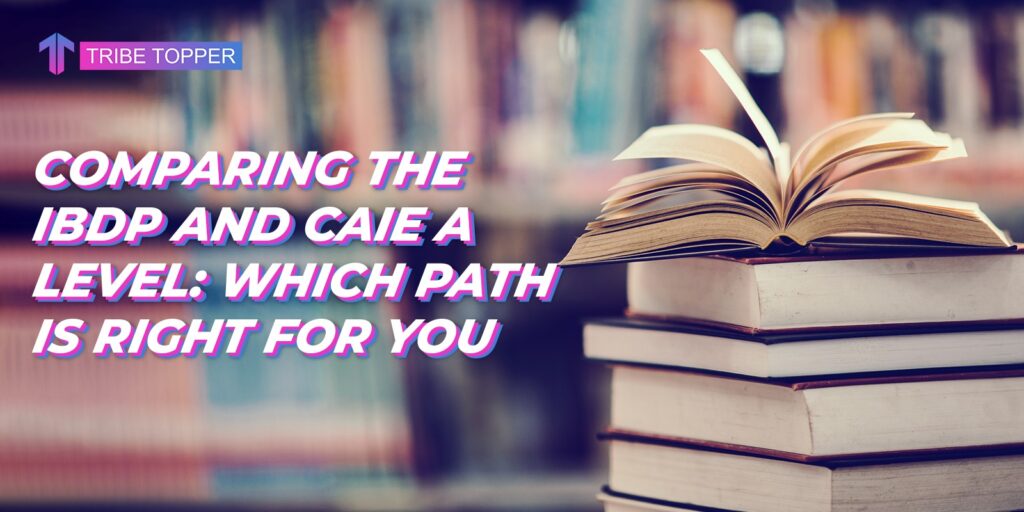Comparing the IBDP and CAIE A Level

Comparing the IBDP and CAIE A Level: Which path is right for you?
CAIE A Level and IBDP are two programs that are both top-notch. However, while some students gain from the depth of the A-Levels program, others succeed in the breadth of the IBDP Past Paper. The selection of a curriculum that would aid in university admission is one area where most parents struggle, especially when their children are ready to transition from primary to secondary school.
The two options are the A-Level program or the International Baccalaureate (IB) Diploma Programme (IBDP), especially for students attending Cambridge UK curriculum-based schools.
Both courses are well-liked high school curricula students enroll in during their final two years of instruction; the minimum age requirement is 16 to 19.
It’s critical to realize that rather than debating the finest curriculum, we should concentrate on a student’s study habits, patterns, and prior educational experiences since these will provide us insight into the former.

Both curricula provide education at the same level and are accepted as university entry requirements.
When the A-Level test boards and the International Baccalaureate Organisations construct their topic curriculum, they collaborate with universities to ensure they are at the right standard and contain the content students need to start university study.
A level mandates students to study at least three topics (in any combination) besides English. In contrast, IB is made to guarantee students take a variety of subjects, totaling six. In addition, the IB offers a required core curriculum that comprises a Theory of Knowledge, an Extended Essay, and a CAS (Creativity, Action, and Service) evaluation of the student. You must “pass” this core and achieve high marks in your six subjects to receive a diploma. While IB employs a points system (the perfect score is 45 points), where 24 points or more secure an IB Diploma, A levels use letters, with A* being the highest grade. The Diploma effectively serves as a global credential.
This guarantees that the topic matter in both programs is broadly identical. Both are recognized and well-known by all major universities, and thousands of students worldwide take them each year.
A Levels:
- Encourages in-depth knowledge and is primarily exam-focused. Students who take A Levels tend to become more specialized and concentrate on three to four topic areas corresponding to the path they would likely take in higher education.
- Given that education depends on textbooks, parents are more aware of the learning process.
- Three subjects minimum
- A* is the highest grade in a letter grade.
- Subject flexibility: A child skilled with numbers can enroll in maths, advanced maths, and physics.
International Baccalaureate
- Promotes a global perspective through inquiry-based instruction and internal assessments balanced with tests. Until the age of 16, the International Baccalaureate Diploma Programme (IBDP) maintains the comprehensive and balanced approach to learning typically seen in school curricula.
- Since internal exams and essays are research-based and student-specific, some parents feel their involvement is diminished.
- Six subjects minimum, including three at the higher and three at the standard levels.
- Subjects are graded on a scale of 1 to 7, with 24 points required for a diploma and 12 points for HL subjects.
- To balance the program, students need a variety of humanities, sciences, and languages.
IB Diploma Subject Details:
Students take six different disciplines, including two languages, maths, science, humanities, and, if they want, an arts subject.
Additionally, students must complete three basic requirements:
- A 4,000-word extended essay.
- Study of the Theory of Knowledge.
- Participation in CAS activities, which include Creativity, Activity, and Service.
A-Levels Subject Details:
Students in this program must take three to four subjects. Most schools will provide substantial extracurricular activities and study programs, even though they are not A-Level subjects.
Both programs have respectable credentials. We must decide what best matches the pupil after understanding their needs.
Some might think the more specialist and in-depth offerings through A-Levels are better suited to pupils wanting to pursue engineering or medicine at the university. This is only a theory, though.
A student with excellent A-Level scores has just as much chance of getting into a prestigious university as a student with stellar IB Diploma scores.
The differences are found in the methods and what works best for certain students. Others may gain more from focusing their studies on the A-Levels, while some pupils will thrive on the IB’s greater breadth.
Children who work hard will succeed in both the IB and the A-Levels.
This makes things clearer and makes it easier for parents to comprehend the curricula with CAIE A Mock Paper. Students with IBDP and A-Levels are placed well in universities.
All the very best.





